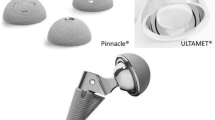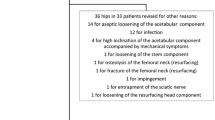Abstract
Purpose
Most factors considered to affect blood metal ions following metal-on-metal hip replacement are based on hip resurfacing patients. The study aims were to determine which factors affect blood metal ion concentrations following metal-on-metal total hip replacement (MoM THR).
Methods
All unilateral MoM THR patients at one centre with whole-blood cobalt (Co) and chromium (Cr) concentrations measured up to May 2013 were included. Blood sampling was at a mean of 4.5 years (range 1.1–11.8 years) postoperatively.
Results
Of 496 patients (mean age 59.1 years; 52.8 % male), blood metal ions >7 μg/l were observed in 9.7 % (n = 48). Large femoral head sizes (≥38 mm) had significantly higher (p < 0.0001) blood metal ions than smaller sizes (28/36 mm). Corail–Pinnacle implants produced significantly lower blood metal ions compared to other implant designs (p < 0.01 Co and Cr). Univariate linear regression demonstrated the only significant predictors of both blood Co and Cr concentrations were femoral head size (R 2 = 8.6 % Co and R 2 = 3.3 % Cr, both p < 0.0001) and implant design (R 2 = 8.8 %, p = 0.005 Co and R2 = 5.1 %, p = 0.003 Cr). When the three THR implant design groups (Corail–Pinnacle, Synergy, Other) were analysed separately, femoral head size no longer significantly affected blood metal ions in any of the three implant design groups.
Conclusions
Implant design was the most important factor affecting blood metal ion concentrations. We recommend the regularity of follow-up be tailored to survival rates of various MoM THR designs rather than according to femoral head size.





Similar content being viewed by others
References
Bozic KJ, Kurtz S, Lau E, Ong K, Chiu V, Vail TP et al (2009) The epidemiology of bearing surface usage in total hip arthroplasty in the United States. J Bone Joint Surg (Am) 91-A:1614–1620
Smith AJ, Dieppe P, Vernon K, Porter M, Blom AW (2012) Failure rates of stemmed metal-on-metal hip replacements: analysis of data from the National Joint Registry of England and Wales. Lancet 379:1199–1204
Zijlstra WP, van den Akker-Scheek I, Zee MJ, van Raay JJ (2011) No clinical difference between large metal-on-metal total hip arthroplasty and 28-mm-head total hip arthroplasty? Int Orthop 35:1771–1776
Fink Barnes LA, Johnson SH, Patrick DA Jr, Macaulay W (2014) Metal-on-metal hip resurfacing compared with total hip arthroplasty: two to five year outcomes in men younger than sixty five years. Int Orthop 38:2435–2440
Cohen D (2012) How safe are metal-on-metal hip implants? BMJ 344:e1410
Bolland BJ, Culliford DJ, Langton DJ, Millington JP, Arden NK, Latham JM (2011) High failure rates with a large-diameter hybrid metal-on-metal total hip replacement: clinical, radiological and retrieval analysis. J Bone Joint Surg (Br) 93-B:608–615
Langton DJ, Jameson SS, Joyce TJ, Gandhi JN, Sidaginamale R, Mereddy P et al (2011) Accelerating failure rate of the ASR total hip replacement. J Bone Joint Surg (Br) 93-B:1011–1016
Langton DJ, Jameson SS, Joyce TJ, Hallab NJ, Natu S, Nargol AV (2010) Early failure of metal-on-metal bearings in hip resurfacing and larger-diameter total hip replacement: a consequence of excess wear. J Bone Joint Surg (Br) 92-B:38–46
Smith AJ, Dieppe P, Howard PW, Blom AW, National Joint Registry for England and Wales (2012) Failure rates of metal-on-metal hip resurfacings: analysis of data from the National Joint Registry for England and Wales. Lancet 380:1759–1766
Medical and Healthcare Products Regulatory Agency (MHRA) (2010) Medical device alert: ASR™ hip replacement implant manufactured by DePuy International Ltd. MDA/2010/069. http://www.mhra.gov.uk/. Accessed 19 Nov 2014
Medical and Healthcare products Regulatory Agency (MHRA) (2012) Medical device alert: all metal-on-metal (MoM) hip replacements. MDA/2012/036. http://www.mhra.gov.uk/. Accessed 19 Nov 2014
Sidaginamale RP, Joyce TJ, Lord JK, Jefferson R, Blain PG, Nargol AV et al (2013) Blood metal ion testing is an effective screening tool to identify poorly performing metal-on-metal bearing surfaces. Bone Joint Res 2:84–95
Almousa SA, Greidanus NV, Masri BA, Duncan CP, Garbuz DS (2013) The natural history of inflammatory pseudotumors in asymptomatic patients after metal-on-metal hip arthroplasty. Clin Orthop Relat Res 471:3814–3821
Ebreo D, Bell PJ, Arshad H, Donell ST, Toms A, Nolan JF (2013) Serial magnetic resonance imaging of metal-on-metal total hip replacements. Follow-up of a cohort of 28 mm Ultima TPS THRs. Bone Joint J 95:1035–1039
Bernstein M, Desy NM, Petit A, Zukor DJ, Huk OL, Antoniou J (2012) Long-term follow-up and metal ion trend of patients with metal-on-metal total hip arthroplasty. Int Orthop 36:1807–1812
De Haan R, Pattyn C, Gill HS, Murray DW, Campbell PA, De Smet K (2008) Correlation between inclination of the acetabular component and metal ion levels in metal-on-metal hip resurfacing replacement. J Bone Joint Surg (Br) 90-B:1291–1297
Glyn-Jones S, Pandit H, Kwon YM, Doll H, Gill HS, Murray DW (2009) Risk factors for inflammatory pseudotumour formation following hip resurfacing. J Bone Joint Surg (Br) 91-B:1566–1574
Grammatopoulos G, Pandit H, Glyn-Jones S, McLardy-Smith P, Gundle R, Whitwell D et al (2010) Optimal acetabular orientation for hip resurfacing. J Bone Joint Surg (Br) 92-B:1072–1078
Langton DJ, Joyce TJ, Jameson SS, Lord J, Van Orsouw M, Holland JP et al (2011) Adverse reaction to metal debris following hip resurfacing: the influence of component type, orientation and volumetric wear. J Bone Joint Surg (Br) 93-B:164–171
Langton D (2014) Are metal ion levels a trigger for surgical intervention? In: Jones LC, Greenwald AS, Haggard WO (eds) Metal-on-metal bearings. A clinical practicum. Springer, New York, pp 63–82, Chapter 5
Reito A, Moilanen T, Puolakka T, Pajamäki J, Eskelinen A (2014) Repeated metal ion measurements in patients with high risk metal-on-metal hip replacement. Int Orthop 38:1353–1361
Bernstein M, Walsh A, Petit A, Zukor DJ, Huk OL, Antoniou J (2011) Femoral head size does not affect ion values in metal-on-metal total hips. Clin Orthop Relat Res 469:1642–1650
Lavigne M, Belzile EL, Roy A, Morin F, Amzica T, Vendittoli PA (2011) Comparison of whole-blood metal ion levels in four types of metal-on-metal large-diameter femoral head total hip arthroplasty: the potential influence of the adapter sleeve. J Bone Joint Surg (Am) 93-A(Supp 2):128–136
Chang EY, McAnally JL, Van Horne JR, Van Horne JG, Wolfson T, Gamst A et al (2013) Relationship of plasma metal ions and clinical and imaging findings in patients with ASR XL metal-on-metal total hip replacements. J Bone Joint Surg (Am) 95-A:2015–2020
Emmanuel AR, Bergin KM, Kelly GE, McCoy GF, Wozniak AP, Quinlan JF (2014) The effect of acetabular inclination on metal ion levels following metal-on-metal hip arthroplasty. J Arthroplasty 29:186–191
Van Der Straeten C, Grammatopoulos G, Gill HS, Calistri A, Campbell P, De Smet KA (2013) The 2012 Otto Aufranc Award: the interpretation of metal ion levels in unilateral and bilateral hip resurfacing. Clin Orthop Relat Res 471:377–385
Dawson J, Fitzpatrick R, Carr A, Murray D (1996) Questionnaire on the perceptions of patients about total hip replacement. J Bone Joint Surg (Br) 78-B:185–190
Pandit H, Glyn-Jones S, McLardy-Smith P, Gundle R, Whitwell D, Gibbons CL et al (2008) Pseudotumours associated with metal-on-metal hip resurfacings. J Bone Joint Surg (Br) 90-B:847–851
Shrout PE, Fleiss JL (1979) Intraclass correlations: uses in assessing rater reliability. Psychol Bull 86:420–428
Bland JM, Altman DG (1999) Measuring agreement in method comparison studies. Stat Methods Med Res 8:135–160
Pynsent PB, Adams DJ, Disney SP (2005) The Oxford hip and knee outcome questionnaires for arthroplasty. J Bone Joint Surg (Br) 87-B:241–248
Murray DW, Fitzpatrick R, Rogers K, Pandit H, Beard DJ, Carr AJ et al (2007) The use of the Oxford hip and knee scores. J Bone Joint Surg (Br) 89-B:1010–1014
R Core Team (2013) R: a language and environment for statistical computing. R Foundation for Statistical Computing, Vienna
Davda K, Lali FV, Sampson B, Skinner JA, Hart AJ (2011) An analysis of metal ion levels in the joint fluid of symptomatic patients with metal-on-metal hip replacements. J Bone Joint Surg (Br) 93-B:738–745
Matthies AK, Henckel J, Cro S, Suarez A, Noble PC, Skinner J et al (2014) Predicting wear and blood metal ion levels in metal-on-metal hip resurfacing. J Orthop Res 32:167–174
Lewinnek GE, Lewis JL, Tarr R, Compere CL, Zimmerman JR (1978) Dislocations after total hip-replacement arthroplasties. J Bone Joint Surg (Am) 60-A:217–220
National Joint Registry for England and Wales. 10th Annual Report 2013. http://njrcentre.org.uk. Accessed 19 Nov 2014
Cooper HJ, Della Valle CJ, Berger RA, Tetreault M, Paprosky WG, Sporer SM et al (2012) Corrosion at the head-neck taper as a cause for adverse local tissue reactions after total hip arthroplasty. J Bone Joint Surg (Am) 94-A:1655–1661
Langton DJ, Sidaginamale R, Lord JK, Nargol AV, Joyce TJ (2012) Taper junction failure in large-diameter metal-on-metal bearings. Bone Joint Res 1:56–63
Garbuz DS, Tanzer M, Greidanus NV, Masri BA, Duncan CP (2010) The John Charnley Award: metal-on-metal hip resurfacing versus large-diameter head metal-on-metal total hip arthroplasty: a randomized clinical trial. Clin Orthop Relat Res 468:318–325
Beaulé PE, Kim PR, Hamdi A, Fazekas A (2011) A prospective metal ion study of large-head metal-on-metal bearing: a matched-pair analysis of hip resurfacing versus total hip replacement. Orthop Clin N Am 42:251–257
Brodner W, Grübl A, Jankovsky R, Meisinger V, Lehr S, Gottsauner-Wolf F (2004) Cup inclination and serum concentration of cobalt and chromium after metal-on-metal total hip arthroplasty. J Arthroplasty 19:66–70
Fehring TK, Odum S, Sproul R, Weathersbee J (2014) High frequency of adverse local tissue reactions in asymptomatic patients with metal-on-metal THA. Clin Orthop Relat Res 472:517–522
Hart AJ, Satchithananda K, Liddle AD, Sabah SA, McRobbie D, Henckel J et al (2012) Pseudotumors in association with well-functioning metal-on-metal hip prostheses: a case–control study using three-dimensional computed tomography and magnetic resonance imaging. J Bone Joint Surg (Am) 94-A:317–325
Malek IA, King A, Sharma H, Malek S, Lyons K, Jones S et al (2012) The sensitivity, specificity and predictive values of raised plasma metal ion levels in the diagnosis of adverse reaction to metal debris in symptomatic patients with a metal-on-metal arthroplasty of the hip. J Bone Joint Surg (Br) 94-B:1045–1050
Matthies AK, Skinner JA, Osmani H, Henckel J, Hart AJ (2012) Pseudotumors are common in well-positioned low-wearing metal-on-metal hips. Clin Orthop Relat Res 470:1895–1906
Acknowledgments
The authors thank the Royal College of Surgeons of England and the Arthritis Research Trust for providing one of the authors with funding in the form of a Surgical Research Fellowship.
Conflict of interest
The author or one or more of the authors have received or will receive benefits for personal or professional use from a commercial party related directly or indirectly to the subject of this article. In addition, benefits have been or will be directed to a research fund, foundation, educational institution or other nonprofit organisation with which one or more of the authors are associated.
Author information
Authors and Affiliations
Corresponding author
Electronic supplementary material
Below is the link to the electronic supplementary material.
ESM 1
(DOC 39 kb)
Rights and permissions
About this article
Cite this article
Matharu, G.S., Berryman, F., Brash, L. et al. Influence of implant design on blood metal ion concentrations in metal-on-metal total hip replacement patients. International Orthopaedics (SICOT) 39, 1803–1811 (2015). https://doi.org/10.1007/s00264-014-2644-z
Received:
Accepted:
Published:
Issue Date:
DOI: https://doi.org/10.1007/s00264-014-2644-z




